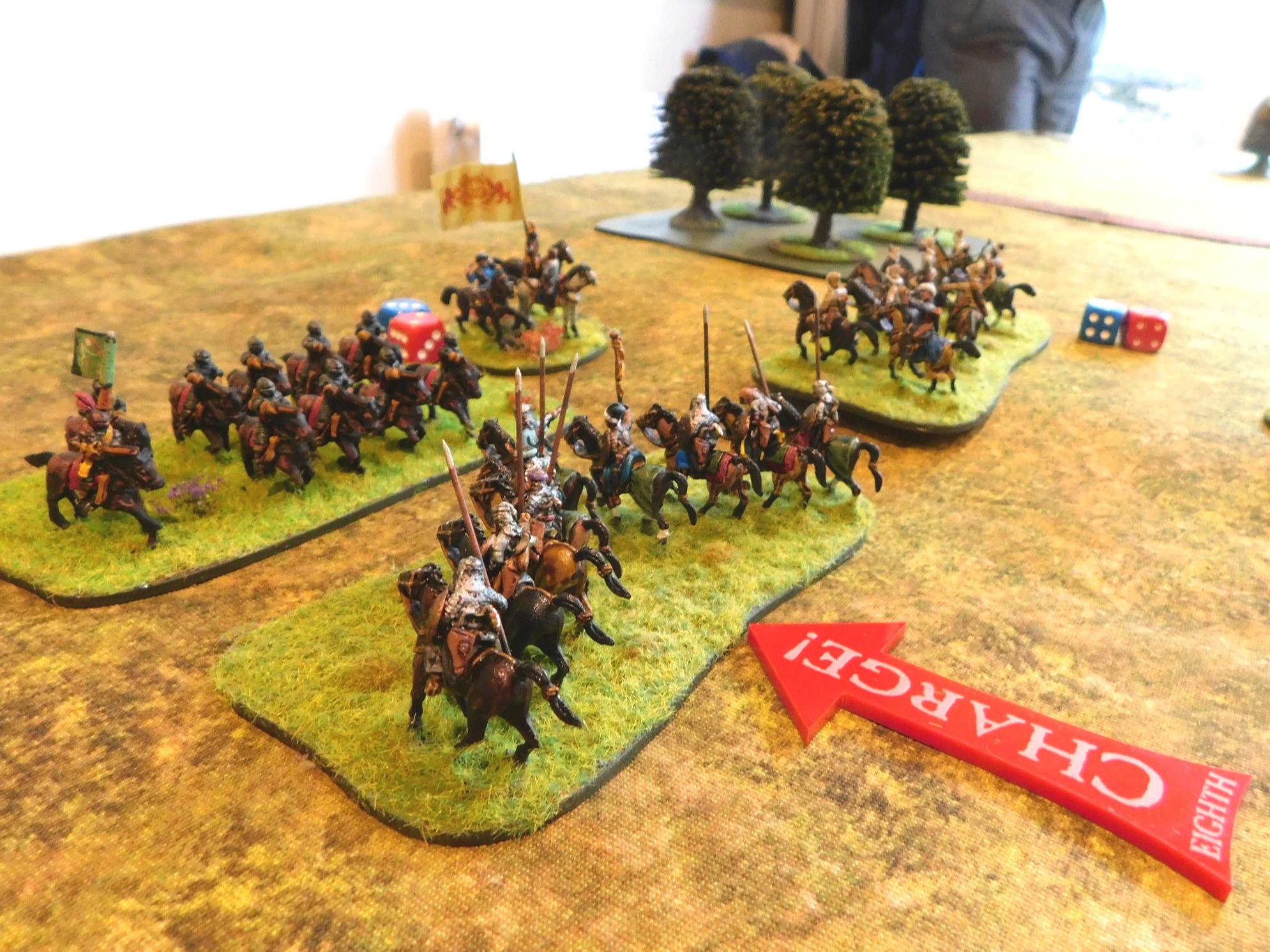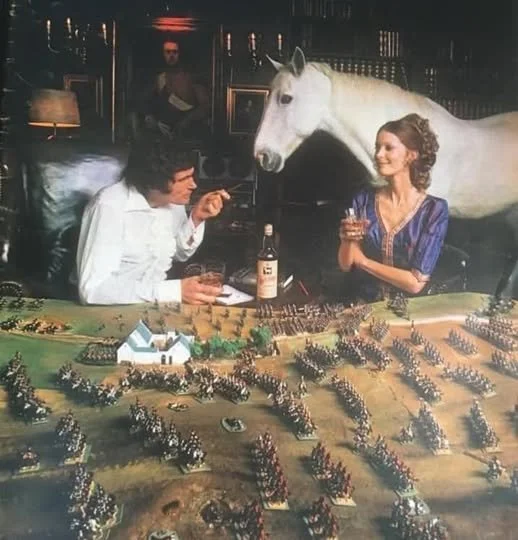FK&P AAR: Swedish vs Cossacks
/Now that I had my Swedes all planned out, it was time to take them into action against my only other vaguely contemporaneous army, the Zaphorogian Cossacks.
This would be an interesting clash, as the two armies were very different: essentially a western pike & shot army (the Swedes) against an eastern pike & shot army (the Cossacks). Indeed, so different were the Cossacks that Bevan, my opponent, asked if he could use the Swedes (despite the dice initially saying otherwise) as he wasn’t sure how to fight with the Cossacks.
The Cossacks, therefore under my command, consisted of a brigade of four tabor war-wagon bases and some artillery; two brigades of Tatar cavalry, each consisting of two horse archer units and one heavier cavalry unit; and two brigades of infantry, each consisting of two Moloitsy units and one Registered Cossack units.
The Left Wing of the Cossacks
The Swedes, commanded by Bevan, were more like a conventional ECW army. They fielded two brigades of Reiters (like harquebusiers) , each with three squadrons; two brigades of pike, one consisting of three “Swedish” or pike-heavy battalia, the other consisting of four “German” standard battalia; and finally a battery of artillery and an orphan brigade of mixed cavalry consisting of a small unit of cuirassiers and another unit of standard Reiters.
The Reiters grouped together on the Swedish left wing
Despite having all the Tatar bowmen to seek out the opposition, the Cossacks were out-scouted and had to deploy first. The ground wasn’t ideal for war-wagons, with the only open space on my left, so that’s where they went along with a brigade of Tatar horse. The two infantry brigades went in the centre and centre right, with the final brigade of horse out on my right. I planned to hold the hedgerows on my right whilst the war wagons dealt with the Swedish left wing, and go from there!
The battlefield from the Cossack side. My CinC is obviously off to visit the church in the middle of the field!
The Swedes massed their cavalry on their left wing, and lined their infantry up next to them but stretching across the rest of the battlefield. That looked like an awful lot of cavalry facing my right, and I could immediately see that Bevan was intending to punch through my right hand cavalry brigade and then bring his horse round onto my flank. Gulp! I’d better win elsewhere rather quickly then!
The Battle Itself
The battle itself divided neatly into two halves: with action taking place on either side of but not along the road that ran up the centre of the field.
On the Cossack left flank, the tabor trundled forward with the Tatar horse easily keeping pace. Opposite them, the pike-heavy Swedish battalia advanced in a slightly ragged line, with the orphan brigade of cavalry behind them.
As the two sides got closer, the tabor turned and deployed ready for action, quickly opening fire with their light guns and muskets. One Swedish battalia was disordered by their fire, so the Tatar horse archers moved forward and double-disordered them with bowfire.
This was too good an opportunity to miss: the veteran Tatar Noble Lancers charged the disordered pike and smashed them from the table! Behind the pike were the Cuirassiers, but they were also dashed from the field by the rampaging Tatars. Unfortunately, the exhausted Nobles were then dispersed by the Reiters accompanying the cuirassiers, but they in turn were then routed by the horse archers following up their Noble comrades.
Meanwhile, one tabor was locked in combat with a battalia of pikemen. The action swayed back and forth, but the Swedish pike were too strong, and the tabor’s crew fled the field.
That was, however, the limit of Swedish success on this flank. Another battalia was hit in the flank and routed by horse archers, and as the battle on the other side of the field reached its climax, more Swedish infantry were about to be charged in the rear by the rampant Tatar horse: the combination of fortress-like tabor shooting any enemy that moved and the nimble Tatar horsemen proving a winnig combination.
It was, however, on the other flank that the battle was decided.
The Swedes wanted to push their horse forward en masse and just overwhelm the outnumbered Tatars in front of them. Unfortunately the cards did not smile on this endeavour, and their attack was first delayed and then delivered piecemeal.
This allowed the Tatars to focus their efforts on the front-runners and break two squadron of horse, but this initial success turned into a gradual retreat in the face of overwhelming numbers of Reiters and, as the battle ended, all three Tatar/Cossack units had been routed and the Swedish horse was preparing to lap around the right flank of the Cossack infantry.
The three Tatar/Cossack units had, however, effectively neutralised the initial Swedish plan of punching huge numbers of Reiters around the Cossack right flank meaning that, along with the successes on the left flank, the Cossacks had a real chance to win the battle with their infantry in the centre…provided they could do so before the Reiters eventually arrived.
The gallery below shows the cavalry action on the right of the Cossack position:
So the battle would be decided in the centre-right axis of the Swedish advance, where the good quality “Swedish” (pike-heavy) infantry moved forward against the Cossack foot: mostly raw infantry armed with long spears rather than pike.
The Cossacks lined the hedgerows near the crossroads and the Swedes advanced to contact. Cossack musket fire was largely ineffective, and they were soon forced to retreat away from the hedgerows in the face of a series of determined charges by the enemy pike.
I brought up reinforcements from the other flank, but so crowded was the nature of the fighting that I couldn’t find a way of extricating my disordered troops from the front line so that I could replace them with fresh. This, as I said, was due to the ferocity of the Swedish attack: continually pressing forward.
And then Lady Luck smiled upon the Cossacks: the Swedish Commanding General was cut down by Cossack musket fire as he led his infantry line forward!
In FK&P, your c-in-c is worth a lot (and I mean a lot) of victory medals, so this really tipped things in my favour. If I could break just two more Swedish units (across the battlefield, not just on this flank, so including all the action on the other flank, happening simultaneously with what I’m now describing) then the day would be mine.
The death of the swedish C-in-C
Unfortunately, Lady Luck is nothing if not even handed, and the very next turn the Cossack commanding general was first lightly wounded and then also killed, losing me an equal number of victory medals!
Death of the Cossack Commanding General
Both sides were now down to just two victory medals remaining: whoever next broke a unit would win the battle.
The initiative was with the Cossacks, so my line of Moloitsy and Registered Cossacks opened fire, bur failed to break the enemy. They returned fire…and this proved too much for one of my raw Moloitsy battalia. They broke and fled the field, taking the rest of my infantry with them.
Seeing their right flank broken and, indeed, with the survivors about to be cut down by rampaging Reiters, the victorious Tatar cavalry and tabor on the left flank remembered an important appointment elsewhere and also skedaddled. The day was with the Swedes!
Aftermath
It had been an epic game that, once again, came down to the final action.
All credit to Bevan for having a great plan and deployment: if his infantry hadn’t carried the day then his Reiters coming in from my right would have finished me off for sure.






























